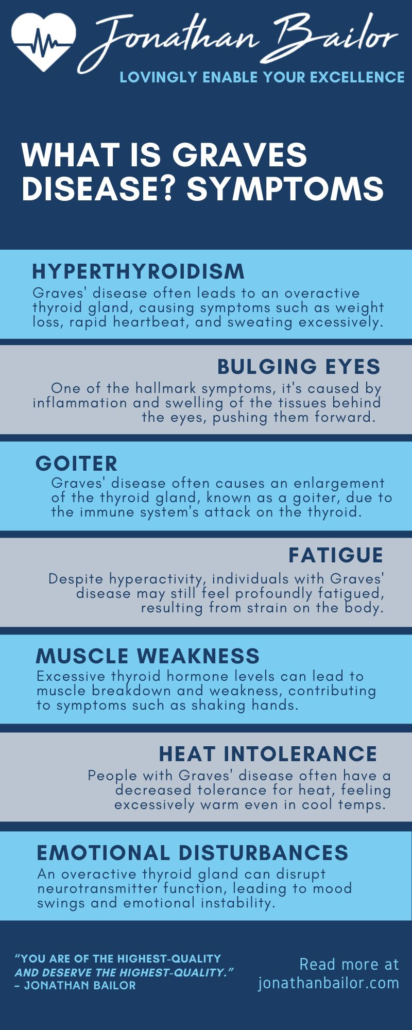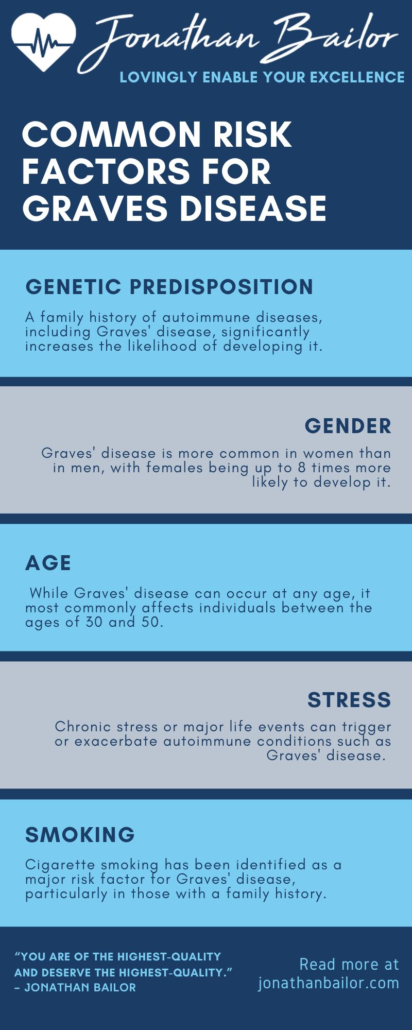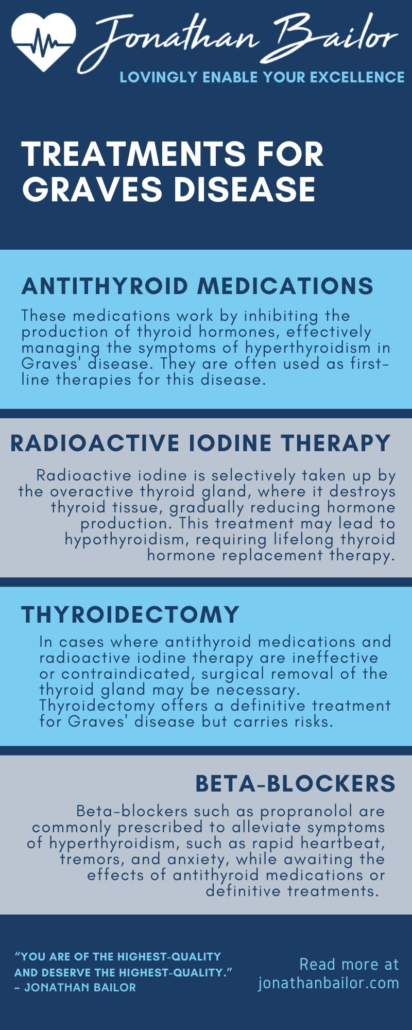What is Graves Disease: Symptoms, Causes, Care & More
When the body sends mixed signals, it’s like navigating through a fog—confusing and sometimes daunting. Graves disease, a condition that whispers in riddles of rapid heartbeats, unexplained weight fluctuations, and a gaze that speaks volumes without words, is one such puzzle. It’s a journey no one expects to embark on, yet understanding this path can shine a light through the mist, offering clarity and direction. In this Thyroid Health Guide, Jonathan Bailor fills in the puzzle pieces for you on the subject of Graves disease.
This exploration is not just about recognizing the signs that the body is whispering but understanding the whispers to speak back with care and compassion. It’s about piecing together the clues—symptoms and causes—with a tapestry of care strategies that envelop the whole person, not just the condition.
Imagine having a map that guides through the terrain of Graves disease, where each marker is a point of knowledge, each path a possibility of care, empowering a journey towards well-being. It’s time to lift the veil on this condition, to share knowledge that arms with power, understanding that inspires action, and empathy that fosters connection.
Sharing this journey could be a beacon of hope for someone in the shadows searching for a guiding light. Let this be a conversation starter, a shared story that resonates, uplifts, and unites in the quest for health and harmony.
Symptoms of Graves Disease
Navigating the landscape of Graves disease requires a guide to the symptoms that signal its presence. These markers are the body’s way of sounding the alarm, a lighthouse shining through the fog of uncertainty that this condition often brings.
Each symptom is a beacon, guiding toward understanding and action. This list isn’t just a collection of signs; it’s a map for those navigating the uncertain waters of Graves disease, offering direction and hope.
- Unexpected weight loss, despite eating habits remaining constant.
- Increased heart rate, palpitations, or irregular heartbeat that seems to come out of nowhere.
- Excessive sweating and an intolerance to heat, making warm days unbearable.
- Changes in mood, including irritability or anxiety, painting emotions in broad, uncharacteristic strokes.
- Fatigue and muscle weakness, turning everyday tasks into exhausting challenges.
- Thyroid enlargement, known as a goiter, which may present as swelling at the base of the neck.
- Change in menstrual cycles, which may become irregular or lighter than normal.
- Frequent bowel movements or changes in bowel habits.
- Thyroid eye disease, including bulging eyes, dry eyes, or vision changes, adding a visual cue to the body’s whispered warnings.
Each symptom is a thread in the tapestry of Graves disease, weaving together to form a picture that, once recognized, can be addressed with care and compassion.

Feeling Better Is Priceless, That's Why We Don't Put A Price On It!
“It’s Like A Free and Medically Valid Version of Noom and Weight Watchers Online”
~ Dr. Doctor Matthew Oleshiak, MD
Click the 'LEARN MORE' button below for free lifetime access to the fast fix program developed by Jonathan and top Ivy League Medical Doctors
LEARN MOREP.S. It's not a free trial. It's not part of the program for free. The entire program is free, forever, for real! No credit card needed.
Understanding the Causes of Graves Disease
The origin of Graves disease lies hidden within the body’s immune system, which, in its zeal to protect, mistakenly turns on its own, targeting the thyroid gland with an intensity that disrupts harmony. In other words, Graves is an autoimmune disease. This autoimmune anomaly prompts the body to produce too much thyroid hormone, a condition called overactive thyroid, propelling the body into overdrive.
Genetics weave through the narrative of Graves disease, suggesting a pattern of inheritance, while environmental factors—stress and infection—add complexity, acting as catalysts that may trigger the onset. This intricate interplay of internal and external forces sets the stage for Graves disease, marking the body’s journey from turmoil to understanding.
Complications of Graves Disease
The journey with Graves disease is not without its challenges, as the condition can unfold into a series of complications that extend beyond the initial symptoms. These complications are not just mere inconveniences; they profoundly impact well-being, altering the course of health in significant ways.
Recognizing these potential complications is crucial, as it arms us with knowledge and underscores the importance of care and vigilance. Each complication is a reminder of the body’s interconnectedness, where the ripple effects of a thyroid imbalance can touch distant shores of health.
- Thyroid storm, a rare but life-threatening increase in thyroid hormone production and intensification of symptoms, demanding immediate medical attention.
- Heart disorders, including abnormal rhythms and changes in the structure and function of the heart.
- Brittle bones (osteoporosis), where the strength and density of bones are diminished, making them more susceptible to fractures.
- Pregnancy issues, such as preterm birth, miscarriage, and preeclampsia, highlighting the condition’s reach across generations.
- Thyroid eye disease, leading to vision problems, discomfort, and potentially severe eye damage.
- Skin conditions, manifesting as Graves dermopathy with red, swollen skin, often on the shins and feet.
Common Risk Factors for Graves Disease
In the tapestry of health, certain threads, when woven together, increase the likelihood of developing Graves disease. These risk factors, unique yet interconnected, paint a picture of predisposition, outlining who might find themselves navigating this condition’s path.
Awareness of these risk factors serves as a beacon, illuminating the landscape of prevention and mindfulness. It’s through understanding these threads that one can approach health with eyes wide open, prepared to engage with care and proactive measures.
- Family history, where the threads of genetics weave a pattern of predisposition, highlighting the role of heredity.
- Gender, with women being more likely to encounter Graves disease, suggesting a tapestry touched by hormonal influences.
- Age, predominantly affecting individuals in their middle years, marking a time of vulnerability.
- Emotional and physical stress acts as a catalyst, potentially triggering the onset in those already susceptible.
- Pregnancy, a period of significant hormonal changes, can heighten the risk, especially in the months following childbirth.
- Smoking, which introduces harmful substances that can affect the immune system and eye health, exacerbating the risk of complications.

Treatments for Graves Disease
In the quest to restore harmony within the body’s landscape, marred by Graves disease, a spectrum of treatments beckons as beacons of hope. These approaches, each with its unique mechanism of action, offer pathways to rebalance the tumultuous seas of thyroid hormones and their production. Embracing treatment is akin to charting a course towards calmer waters, guided by the lighthouse of medical wisdom.
The journey towards well-being is personal and varied, reflecting the individual tapestry of symptoms and circumstances. Herein lies an overview of the treatments, casting light on options that pave the way to equilibrium and health.
Anti-thyroid Medications
These medications act as gentle whispers, urging the thyroid to soften its fervent production of hormones. Methimazole and propylthiouracil, stewards of calm, work within the intricate machinery of the thyroid, dialing back the production to levels that echo normalcy.
The journey with these medications is one of patience as their effects unfold over weeks and months. Regular monitoring becomes a rhythm, ensuring that the dance between too much and too little finds its balance. For many, this treatment is a first step, a door opening to a path lined with the possibility of remission.
Radioactive Iodine Therapy
Imagine a targeted beacon that specifically illuminates the overactive cells of the thyroid, guiding them to rest. Radioactive iodine therapy offers this precision, a drinkable form of radiation that the thyroid cells absorb, diminishing its zeal from within.
The aftermath often tilts towards a quieter thyroid, sometimes too quiet, necessitating the lifelong embrace of thyroid hormone replacement. This treatment, a bridge to stability, requires contemplation, weighing the promise of calm against the shift in the body’s hormonal chorus.
Thyroid Surgery
In scenarios where medication whispers go unheard or when the thyroid’s enlargement beckons for space, surgery emerges as a definitive call to tranquility. Removing the thyroid, partial or complete, is a map redrawn, a terrain forever altered. Guided by precision and care, the scalpel promises a resolution yet heralds a new journey with thyroid hormone replacement.
Surgery, a harbinger of immediate change, carries the torch of permanence, illuminating the path for those for whom other treatments stand as fleeting shadows.
Beta-Blockers
While not a treatment for Graves disease itself, beta-blockers serve as calming winds against the stormy symptoms, particularly the rapid heartbeat that often accompanies this condition. They stand as guardians of the present, offering relief while other treatments gently steer the course of the disease.
Beta-blockers, in their role, remind us that sometimes, the healing journey is also about embracing comfort along the way.
Eye Treatments
For those whose eyes bear the brunt of Graves disease, treatments specifically designed to soothe and protect become invaluable allies. From simple lubricants to guard against dryness to more involved surgical procedures to restore function and appearance, each option is a testament to the comprehensive care the condition demands.
Like all others, these treatments are stepping stones, part of a broader strategy aimed at reclaiming health and harmony.

Natural Ways to Manage Graves Disease
Amidst the symphony of medical treatments for Graves disease, there lies a quieter melody—natural ways to harmonize the body’s rhythms. These gentle approaches, rooted in the essence of nature and lifestyle adjustments, complement the broader chorus of care. They are not replacements for medical treatments but co-conductors, enhancing well-being and equilibrium.
Each natural strategy is a thread in the tapestry of holistic health, woven to support the body’s journey toward balance. Here, the spotlight turns to these natural harmonies, inviting exploration and integration into the daily dance of life.
Stress Reduction Techniques
The waves of stress, incessant and overwhelming, can amplify the symphony of symptoms in Graves disease. Techniques such as meditation, yoga, and deep-breathing exercises emerge as sanctuaries of calm, each breath a step away from the tempest of overactivity.
Engaging in these practices is akin to casting an anchor in turbulent seas, providing a steadying presence that can temper the immune system’s overzealous tune. This commitment to tranquility is a gentle reminder that finding peace within can be as transformative as any medicine in the quest for health.
Anti-Inflammatory Diet
Embarking on a dietary journey that emphasizes anti-inflammatory foods is like choosing ingredients for a healing potion. Rich in colorful vegetables, fruits (emphasizing berries and citrus for their lower sugar content), and lean proteins, this diet avoids the inflammation that can exacerbate autoimmune responses.
Incorporating healthy fats from sources like avocados, olive oil, and fatty fish nourishes without the need for grains, offering a foundation that supports the body’s natural equilibrium. This dietary path is not about deprivation but selecting the nourishment that whispers health to every cell.
Regular Moderate Exercise
Moderate exercise, the body’s rhythm set to motion, offers a counterpoint to the accelerated pace of Graves disease. Engaging in activities such as walking, swimming, or cycling for moderation—not exhaustion—can enhance cardiovascular health without overstimulating the thyroid.
This physical harmony, a balance between activity and rest, underscores the importance of listening to the body’s cues, ensuring that exercise remains a source of vitality rather than a toll on well-being.
Adequate Sleep
In the orchestra of health, sleep is the rest between notes, essential for the music to resonate with clarity and beauty. Prioritizing sleep—aiming for 7-9 hours per night—becomes critical in managing Graves disease. This restorative period allows the body to repair and recalibrate, offering a respite to the immune system and a chance to temper the thyroid’s overactivity.
Embracing sleep hygiene practices, such as maintaining a regular sleep schedule and creating a calming bedtime routine, is akin to tuning an instrument, essential for the performance of life.
Herbal Support
While navigating the natural management of Graves disease, certain herbs have been whispered through the annals of herbal medicine for their supportive roles. Lemon balm and bugleweed, for instance, are often cited in traditional practices for their potential to soothe hyperthyroid conditions.
However, embarking on herbal voyages requires caution and consultation with a healthcare provider, as the terrain is complex and interactions with conventional treatments are possible. This exploration of herbal allies is a journey of respect for nature’s potency, embarked upon with care and guided by knowledge.
Thyroid Health: Frequently Asked Questions
Q1: What are the primary functions of the thyroid gland?
The thyroid gland is akin to a master conductor, orchestrating a symphony of bodily functions with grace and precision. It produces hormones that regulate metabolism, influence heart rate, and govern the efficiency with which calories are converted into energy. This tiny gland nestled in the neck speaks in chemical whispers, guiding the rhythm of the body’s daily functions, ensuring that the tempo of life’s dance maintains its harmony.
Q2: How can I tell if my thyroid is not functioning properly?
Signs that the thyroid may be out of tune include unexpected changes in weight, alterations in mood or energy levels, fluctuations in heart rate, and changes in skin texture or hair health. These signals are the body’s way of indicating that the harmony of metabolism and energy regulation may be facing disruptions, prompting a closer look at thyroid health through consultation with a healthcare provider.
Q3: Can diet influence thyroid health?
Indeed, the foods consumed play a pivotal role in supporting thyroid function. A diet rich in fruits, vegetables, lean proteins, and healthy fats, such as selenium, zinc, and iodine, provides the nutrients necessary for thyroid health. Emphasizing anti-inflammatory foods and staying hydrated can bolster the body’s natural defenses and support the delicate balance of thyroid activity.
Q4: What is the difference between hypothyroidism and hyperthyroidism?
Hypothyroidism occurs when the thyroid whispers too softly (underactive thyroid), leading to a slowdown in metabolic functions, while hyperthyroidism occurs when the thyroid speaks too loudly, accelerating bodily processes. Each condition presents unique challenges, from fatigue and weight gain in hypothyroidism to weight loss and nervousness in hyperthyroidism, highlighting the thyroid’s critical role in maintaining the body’s equilibrium.
Q5: Are there natural ways to support thyroid health?
Supporting thyroid health naturally involves a harmonious blend of lifestyle choices, from embracing a nutrient-rich diet to engaging in regular, moderate exercise and ensuring adequate sleep. Stress reduction techniques, such as mindfulness and yoga, can also be supportive, helping maintain the internal balance necessary for optimal thyroid function. These natural approaches are companions on the journey to wellness, enhancing overall health and thyroid harmony.
Embracing Thyroid Health Together
In the journey through the landscapes of thyroid health, knowledge and understanding are the compasses that guide us. This exploration into symptoms, causes, complications, and natural management strategies for conditions like Graves disease is a shared voyage that illuminates the paths to well-being. Engaging with this wisdom makes the journey less solitary and enriched by the support and compassion of those who walk alongside us.
Let’s extend this circle of care by sharing these insights with friends and family through social media and email, inviting them to join us on this journey toward understanding and health. Together, we navigate the waters of thyroid health, empowered by knowledge and united in hope.
Feeling Better Is Priceless, That's Why We Don't Put A Price On It!
“It’s Like A Free and Medically Valid Version of Noom and Weight Watchers Online”
~ Dr. Doctor Matthew Oleshiak, MD
Click the 'LEARN MORE' button below for free lifetime access to the fast fix program developed by Jonathan and top Ivy League Medical Doctors
LEARN MOREP.S. It's not a free trial. It's not part of the program for free. The entire program is free, forever, for real! No credit card needed.




